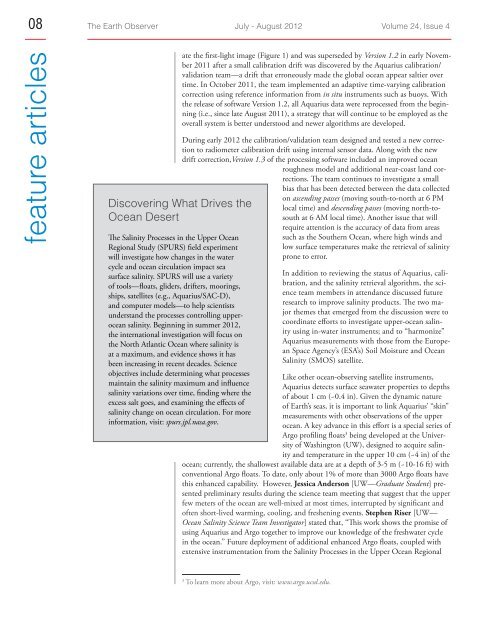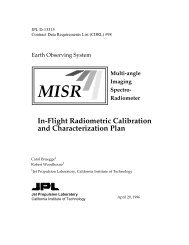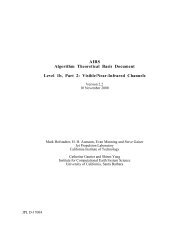Download - NASA's Earth Observing System
Download - NASA's Earth Observing System
Download - NASA's Earth Observing System
Create successful ePaper yourself
Turn your PDF publications into a flip-book with our unique Google optimized e-Paper software.
08<br />
The <strong>Earth</strong> Observer July - August 2012 Volume 24, Issue 4<br />
feature articles<br />
Discovering What Drives the<br />
Ocean Desert<br />
The Salinity Processes in the Upper Ocean<br />
Regional Study (SPURS) field experiment<br />
will investigate how changes in the water<br />
cycle and ocean circulation impact sea<br />
surface salinity. SPURS will use a variety<br />
of tools—floats, gliders, drifters, moorings,<br />
ships, satellites (e.g., Aquarius/SAC-D),<br />
and computer models—to help scientists<br />
understand the processes controlling upperocean<br />
salinity. Beginning in summer 2012,<br />
the international investigation will focus on<br />
the North Atlantic Ocean where salinity is<br />
at a maximum, and evidence shows it has<br />
been increasing in recent decades. Science<br />
objectives include determining what processes<br />
maintain the salinity maximum and influence<br />
salinity variations over time, finding where the<br />
excess salt goes, and examining the effects of<br />
salinity change on ocean circulation. For more<br />
information, visit: spurs.jpl.nasa.gov.<br />
ate the first-light image (Figure 1) and was superseded by Version 1.2 in early November<br />
2011 after a small calibration drift was discovered by the Aquarius calibration/<br />
validation team—a drift that erroneously made the global ocean appear saltier over<br />
time. In October 2011, the team implemented an adaptive time-varying calibration<br />
correction using reference information from in situ instruments such as buoys. With<br />
the release of software Version 1.2, all Aquarius data were reprocessed from the beginning<br />
(i.e., since late August 2011), a strategy that will continue to be employed as the<br />
overall system is better understood and newer algorithms are developed.<br />
During early 2012 the calibration/validation team designed and tested a new correction<br />
to radiometer calibration drift using internal sensor data. Along with the new<br />
drift correction,Version 1.3 of the processing software included an improved ocean<br />
roughness model and additional near-coast land corrections.<br />
The team continues to investigate a small<br />
bias that has been detected between the data collected<br />
on ascending passes (moving south-to-north at 6 PM<br />
local time) and descending passes (moving north-tosouth<br />
at 6 AM local time). Another issue that will<br />
require attention is the accuracy of data from areas<br />
such as the Southern Ocean, where high winds and<br />
low surface temperatures make the retrieval of salinity<br />
prone to error.<br />
In addition to reviewing the status of Aquarius, calibration,<br />
and the salinity retrieval algorithm, the science<br />
team members in attendance discussed future<br />
research to improve salinity products. The two major<br />
themes that emerged from the discussion were to<br />
coordinate efforts to investigate upper-ocean salinity<br />
using in-water instruments; and to “harmonize”<br />
Aquarius measurements with those from the European<br />
Space Agency’s (ESA’s) Soil Moisture and Ocean<br />
Salinity (SMOS) satellite.<br />
Like other ocean-observing satellite instruments,<br />
Aquarius detects surface seawater properties to depths<br />
of about 1 cm (~0.4 in). Given the dynamic nature<br />
of <strong>Earth</strong>’s seas, it is important to link Aquarius’ “skin”<br />
measurements with other observations of the upper<br />
ocean. A key advance in this effort is a special series of<br />
Argo profiling floats 3 being developed at the University<br />
of Washington (UW), designed to acquire salinity<br />
and temperature in the upper 10 cm (~4 in) of the<br />
ocean; currently, the shallowest available data are at a depth of 3-5 m (~10-16 ft) with<br />
conventional Argo floats. To date, only about 1% of more than 3000 Argo floats have<br />
this enhanced capability. However, Jessica Anderson [UW—Graduate Student] presented<br />
preliminary results during the science team meeting that suggest that the upper<br />
few meters of the ocean are well-mixed at most times, interrupted by significant and<br />
often short-lived warming, cooling, and freshening events. Stephen Riser [UW—<br />
Ocean Salinity Science Team Investigator] stated that, “This work shows the promise of<br />
using Aquarius and Argo together to improve our knowledge of the freshwater cycle<br />
in the ocean.” Future deployment of additional enhanced Argo floats, coupled with<br />
extensive instrumentation from the Salinity Processes in the Upper Ocean Regional<br />
3<br />
To learn more about Argo, visit: www.argo.ucsd.edu.







